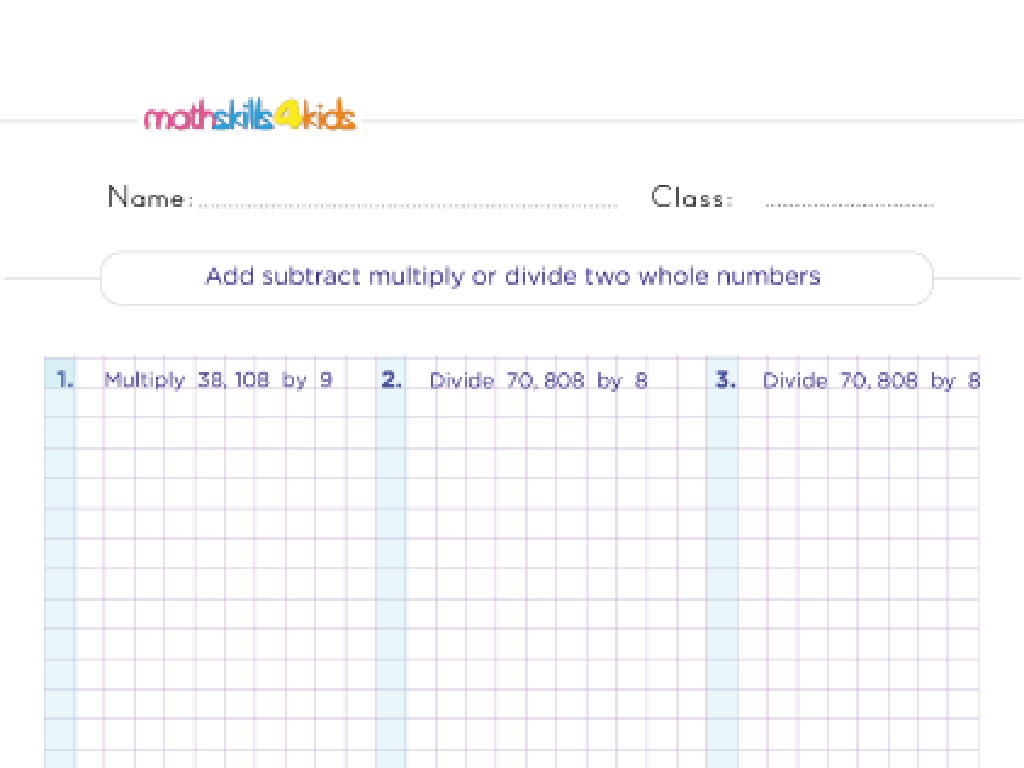Acids And Bases
Subject: Science
Grade: High school
Topic: Chemistry
Please LOG IN to download the presentation. Access is available to registered users only.
View More Content
Introduction to Acids and Bases
– Nature of acidic substances
– Acids taste sour, react with metals, and turn blue litmus red
– Defining bases and their nature
– Bases feel slippery, taste bitter, and turn red litmus blue
– Everyday examples of acids and bases
– Vinegar (acetic acid), citrus fruits (citric acid), baking soda (sodium bicarbonate), soap (sodium hydroxide)
– Importance in daily life and industry
|
This slide introduces the fundamental concepts of acids and bases, which are two classes of substances with distinct properties and behaviors. Acids are substances that taste sour, can react with metals to produce hydrogen gas, and have the ability to change the color of blue litmus paper to red. Bases, on the other hand, feel slippery, taste bitter, and can change the color of red litmus paper to blue. Students should be familiar with common examples of acids and bases from everyday life, such as vinegar, citrus fruits, baking soda, and soap. Understanding these substances is crucial not only in daily life but also for various industrial processes. Encourage students to think of more examples and to observe the properties of acids and bases in a safe and supervised environment.
Properties of Acids
– Acids have a sour taste
– React with metals for H2 gas
– Zinc and hydrochloric acid react to release hydrogen gas
– Turn blue litmus paper red
– Characteristic reactions with bases
– Acids neutralize bases to form salt and water
|
This slide aims to describe the fundamental properties of acids that are observable in a high school chemistry lab. While acids are known to have a sour taste, it is critical to emphasize that tasting chemicals in a lab setting is strictly prohibited for safety reasons. The reaction of acids with certain metals, such as zinc or magnesium, is a common experiment to demonstrate the release of hydrogen gas. The color change of blue litmus paper to red is a classic and simple test to confirm the acidic nature of a substance. Lastly, the slide touches upon the neutralization reaction, which is a key concept in understanding the behavior of acids when they come into contact with bases. This foundational knowledge sets the stage for further exploration of acid-base chemistry, including titration and pH calculations.
Properties of Bases
– Bases have a bitter taste
– Bases feel slippery
– Bases do not react with metals
– Unlike acids, bases won’t corrode metals
– Bases turn red litmus blue
– An indicator of basicity in chemical testing
|
This slide outlines the fundamental properties of bases, which are substances that can neutralize acids. It’s crucial to emphasize safety in the lab: students should never taste or touch chemicals. Bases typically have a bitter taste and a slippery feel, but this is only for informational purposes and not for practical testing. Bases do not react with metals, which is a contrast to acids that often do. The change of red litmus paper to blue is a classic test for basicity. During the lesson, demonstrate the litmus test with a safe base solution, and discuss everyday examples of bases, such as baking soda and soap, to make the concept more relatable.
Understanding the pH Scale
– pH scale definition
– A measure of how acidic or basic a solution is.
– pH scale range: 0 to 14
– Examples of varying pH substances
– Lemon juice (pH 2), pure water (pH 7), soap (pH 10)
– Importance of pH in chemistry
– pH affects chemical reactions, living organisms, and environment.
|
The pH scale is a logarithmic scale used to specify the acidity or basicity of an aqueous solution. It ranges from 0 to 14, with 7 being neutral. pH values below 7 indicate acidity, while values above 7 indicate basicity. Common examples include lemon juice and stomach acid on the acidic end, pure water at neutral, and soap and bleach on the basic end. Understanding pH is crucial in fields like medicine, biology, and environmental science, as it affects how substances interact and react with each other. Encourage students to test pH of household items and predict their effects based on their pH value.
Understanding Indicators in Chemistry
– Defining indicators
– Substances that show visual change with pH
– Natural vs Synthetic indicators
– Natural: litmus, red cabbage; Synthetic: phenolphthalein, methyl orange
– Mechanism of indicator function
– Change color due to pH-induced molecular structure change
– Application in acid-base reactions
|
Indicators are substances that change color when added to acidic or basic solutions, providing a visual way to determine the pH of a solution. This slide will cover the definition of indicators, differentiate between natural indicators like litmus paper and synthetic ones like phenolphthalein, and explain how indicators function on a molecular level. Students should understand that indicators work by undergoing a structural change when the pH of their environment changes, which results in a color change. This concept is crucial for laboratory work involving titrations and pH testing. Encourage students to think about the practical applications of indicators in everyday life, such as testing soil acidity for gardening.
Neutralization Reaction: Acids Meet Bases
– Acid-Base reaction fundamentals
– When an acid and a base react, they neutralize each other.
– Neutralization forms water and salt
– The reaction typically produces salt and H2O as products.
– Real-world neutralization applications
– Neutralization is used in agriculture to treat soil and in medicine for antacid tablets.
|
This slide introduces the concept of neutralization reactions in chemistry, where an acid and a base react to form water and a salt. It’s important to emphasize that neutralization is a specific type of double displacement reaction. Provide examples of neutralization reactions, such as the reaction between hydrochloric acid and sodium hydroxide to form sodium chloride and water. Discuss real-life applications, including how farmers use lime to neutralize acidic soil, or how antacids work to neutralize excess stomach acid. Encourage students to think of other examples where neutralization reactions are beneficial in everyday life.
Strength of Acids and Bases
– Strong vs Weak Acids/Bases
– Strong acids/bases fully ionize, weak ones partially
– Degree of Ionization
– Ionization refers to the release of ions in water
– Examples of Strong Acids/Bases
– Strong acids: HCl, H2SO4. Used in industry and labs
– Examples of Weak Acids/Bases
– Weak acids: Acetic acid. Weak bases: Ammonia. Used in food and cleaning
|
This slide aims to differentiate between strong and weak acids and bases based on their ionization in water. Strong acids and bases ionize completely, releasing more ions, which makes them more reactive. Weak acids and bases only partially ionize, making them less reactive. Examples include hydrochloric acid (HCl) and sulfuric acid (H2SO4) as strong acids, commonly used in industrial processes and laboratory settings. Acetic acid, found in vinegar, is a weak acid, while ammonia, used in household cleaners, is a weak base. Understanding the strength of acids and bases is crucial for predicting their behavior in chemical reactions and their applications in various industries.
Class Activity: Testing pH Levels
– Gather required materials
– pH strips, red cabbage juice, various solutions
– Follow safety guidelines
– Wear safety goggles, gloves, and aprons
– Step-by-step pH testing
– Dip pH strip in solution, compare color to chart
– Document and discuss results
|
This activity is designed to help students understand the concept of pH and how it is measured. Students will use pH strips or red cabbage juice as an indicator to test the acidity or basicity of various household solutions like vinegar, baking soda, and soap. It’s crucial to emphasize the importance of safety by wearing protective gear. Provide a clear, step-by-step guide for the students to follow during the experiment, including dipping the pH strip into each solution and then comparing the resulting color to a pH chart. After testing, students should document their findings and be prepared to discuss the results, reinforcing their understanding of acids, bases, and neutral substances.
Acids and Bases: Summary and Significance
– Recap of acid-base concepts
– Acids donate protons, bases accept them
– Significance in chemistry and daily life
– pH scale, neutralization, and common examples
– Encourage curiosity and questions
– Open floor for discussion
|
This slide aims to consolidate the students’ understanding of acids and bases, emphasizing the importance of these concepts in both chemistry and everyday life. Highlight the proton donation of acids and acceptance by bases, the pH scale, and the role of neutralization reactions. Stress how this knowledge is applicable in various real-world scenarios, such as food science, medicine, and environmental science. Encourage students to ask questions about anything they may find confusing or intriguing, fostering an environment of curiosity and open discussion. This is also an opportunity to address any misconceptions and to ensure that students are comfortable with the material before moving on.
Homework: Industrial Acids and Bases
– Research an industrial acid
– Research an industrial base
– Write a report on properties and uses
– Include physical and chemical properties, applications, and safety measures
– Share findings in next class
– Be prepared to discuss and answer questions
|
This homework assignment is designed to deepen students’ understanding of acids and bases by exploring their practical applications in industry. Students should select one acid and one base commonly used in industrial processes and investigate their properties, such as pH level, corrosiveness, and reactivity, as well as their uses in manufacturing, cleaning, or other applications. The report should also address proper handling and safety procedures to highlight the importance of safety in chemical handling. Encourage students to use credible sources for their research. In the next class, students will have the opportunity to present their findings, facilitating peer learning and discussion.






